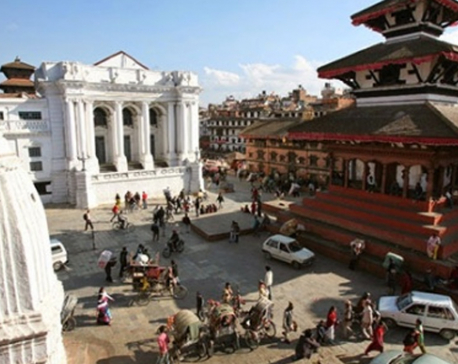
OR
Low inflation rate
The prices of daily goods were bound to go up due to the severe shortages resulting from the April 2015 earthquakes and the crippling five months of border blockade. Inflation, as measured by the Consumer Price Index (CPI), was thus a worrying 10.2 percent in mid-March 2016. The CPI is based on weighted average prices of a basket of consumer goods and services, such as daily edibles, transport services and medicine. The corresponding inflation figure for mid-March 2017 was 2.9 percent, the lowest in a decade. This is great news for the vast majority of Nepalis who have seen their incomes steadily erode in value owing to sustained double-digit inflation. The poorer you are, the greater the proportion of your income that you spend on food. Thus the negative inflation rate of 0.4 percent on food products for mid-March, compared to a whopping 10.3 percent corresponding inflation in the same period last year, will cheer the daily wage-earners and others in the low-income brackets. The prices of pulses and legumes, for instance, have fallen by 11.2 percent in this period while vegetables are cheaper by 8.3 percent. People’s main concern now is if this welcome let up in inflation can be sustained.
It probably won’t be. It is important to put recent price decreases into perspective. After rapidly increasing in the 2015-16 period, they were bound to come down as normal supplies resumed following the lifting of the blockade in February 2016. The second reason for low inflation this year is a good monsoon. Prices came down as domestic crop and vegetable production increased. Since Nepal imports most of its vegetables and edibles from India, low inflation across the border was also imported. As we have repeatedly pointed out in this space, the only way to ensure sustainable high economic growth and low inflation is to improve our own production capacity. Indian crop-growers enjoy huge subsidies while buying farming implements and fertilizers, which not only increases production but also makes their rice and wheat more competitive. Nepal has failed to respond with similar help for its farmers. Moreover, most of our fertile land is barren as youths have left for employment abroad. Perhaps more of them could be persuaded to stay put and till their lands through better targeted agricultural subsidies, guaranteed markets and year-round irrigation.
The other surefire way to check inflation is for the country to produce more of the goods and services that it needs and can export, which in turn is only possible if our businesses and industries are healthy. But our productive capacities have instead been steadily eroding. One indicator of this loss of our productive capacity is our ballooning trade deficit, which in the first five months of this fiscal increased by nearly 30 percent compared to the corresponding period the previous year. Nepal’s competitive advantage in garments and pashmina products, until recently among the country’s chief exports, has been steadily eroding. Narendra Modi is pushing ahead with his ‘Make in India’ campaign, the main goal of which is to boost India’s manufacturing base and promote the use of locally-made products in India. We need a similar political focus on the economy. Otherwise we will have to continue to rely on the heavens and our neighbors for the health and wellbeing of our own people.
You May Like This

Souls of my city: Grandfather Story #2
Daicha Maharjan is a farmer and a grandfather. He can be found sitting in a sunlit corner in Patan Durbar... Read More...

New ‘Handmaid’s Tale’ TV version ‘not a feminist story,’ says its star
The cast of a new adaptation of dystopian novel “The Handmaid’s Tale” insisted on Friday they did not set out... Read More...

Cover story: Time stands still
A lot can happen in a year and Ashrumai Shrestha can see that. Her neighbor’s daughter in law has become... Read More...






Just In
- Australia reduces TR visa age limit and duration as it implements stricter regulations for foreign students
- Govt aims to surpass Rs 10 trillion GDP mark in next five years
- Govt appoints 77 Liaison Officers for mountain climbing management for spring season
- EC decides to permit public vehicles to operate freely on day of by-election
- Fugitive arrested after 26 years
- Indian Potash Ltd secures contract to bring 30,000 tons of urea within 107 days
- CAN adds four players to squad for T20 series against West Indies 'A'
- ‘Precast' technology introduced in the construction of bridges along Muglin-Pokhara road












Leave A Comment